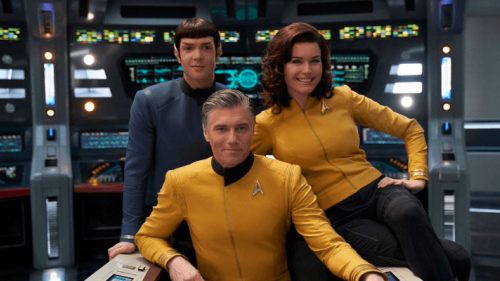Basic Movie Science: STAR TREK INTO DARKNESS
Before I dive into a discussion of the science in the latest Star Trek film, I’d like to take a moment to prevail upon why we should be doing this in the first place. I’ve found that this sort of thing touches a lot of nerves, and it’s easy to come off as a smartypants taking potshots at a summer popcorn flick that, quite honestly, never asked for that level of scrutiny. I’d probably never attempt this exercise with anything Star Wars or any of the Marvel Universe pictures, but I maintain that Star Trek is a different beast entirely. I’ll try to explain that myself below, but first, let me submit a recent quote from Trek writer/producer Damon Lindelof:
I do think what's cool about Trek is it's not scifi fantasy. We view it as hardcore scifi. So you want there to be some sort of technological explanation behind everything.
So, we can all agree that we’re in a safe space here, and that Lindelof is inviting this kind of discussion. Right? Good.
The quote touches on what, I believe, really sets Trek apart from other popular film franchises. The original Star Trek series launched during the middle of the Apollo program and, taking its cues from the popular energy propelling the moon shot, it postulated an upbeat vision of a future we could achieve if we could just get our collective act together. This wasn’t a galaxy and time far, far away - it was our future, storyboarded and there for us to build, if only we had the good sense to do so.
The creators concocted a few devices more or less rooted in the theoretical physics of the time - warp drive, transporters, subspace radios, etc. - but even these had their rules and limits, and they only took the Enterprise crew so far. Both the astronauts of the day and the Enterprise crew of the future were on the edge of what was possible, and we could see our struggles to leave Earth mirrored in theirs to explore the galaxy. And for all the inspiration it drew from the space program, Star Trek returned the favor in spades, inspiring subsequent generations of scientists and engineers (myself included) to work on the building blocks of that vision. And for that reason, I think it’s important that Trek continue to be grounded in reality.
So, how exactly does Star Trek Into Darkness*, from writers Lindelof, Roberto Orci, and Alex Kurtzman, hold up to this kind of scrutiny? Honestly, better than I first thought. I will say this upfront: as a dyed-in-the-wool Trekkie, I’m not a fan of Into Darkness as a Star Trek film. For reasons I won’t belabor, since they’ve been covered better by other authors on this site, I found it a disappointing rehash of a story told with far greater impact the first time. And on my first (and second) viewing, my kneejerk reaction was to dismiss the science as uniformly sloppy. The great thing about the scientific process, though, is that it demands we check our preconceptions at the door and engage a topic dispassionately. And in researching my objections in greater depth, damn if I didn’t prove myself wrong and find in the authors’ favor on one major point. That isn’t to say that Into Darkness gets its science mostly right - there’s still a fair amount to object to here - but it’s definitely more of a mixed bag than I first thought.
Spoilers follow, so be warned.
There’s a difference between movie science that violates real-world principles and movie science that violates story-world principles. As I said earlier, the creators get to decide how they want to fudge things in the conceptual stage, and for well-executed science fiction those altered rules are held in as much reverence as the real-world ones that still apply. Now, levying criticisms here is something of a Pandora’s box of nerdery, as Devin and I found out last year by dismissing the underwater Enterprise in the Into Darkness trailer. It’s even worse when counter-critics can mine nearly 50 years of franchise material chock full of its own inconsistencies to cite in their dismissals. But I’d hope that a reboot gets us back to the point that we’re still skewing pretty closely to the old (new) rules after only two movies. And on this point, I find that Into Darkness largely fails. I still maintain that Kirk hiding the Enterprise underwater on Nibiru makes absolutely no sense, but that argument is rooted in the fact that an Enterprise that can pop down to a planet’s surface with ease is fundamentally contrary to the notion of how starships work in Trek.
It’s fair to answer that, according to the new rules of the reboot, this is how starships work now in Star Trek. But if that’s the case, we have absolutely no need for a spacedock orbiting the Earth, since any purpose it serves could be far more easily accomplished planetside. And yet both Star Trek Into Darkness and the 2009 reboot have showed us an impressive orbital complex servicing starships. A fundamental rule of spaceflight is that you don’t do anything on orbit that you can more cheaply or easily do on Earth, so the space dock just doesn’t square with an atmospherically operated Enterprise.
There are a number of other such inconsistencies**, but they’re mostly in the realm of story-world science. So how does the real stuff fare? As I mentioned earlier, a couple of points caught my attention, and I was convinced that the writers had dropped the ball on both. But I was pleasantly surprised when I put pen to paper on the first. They both involve the sequence after the Vengeance knocks the Enterprise out of warp on its way back to Earth. The two ships are hanging above the Moon with the Enterprise badly damaged. After the Enterprise bests its rival, it begins to fall back to Earth, caught in the planet’s gravity.
Since the Moon sits far more prominently in the shot than does the Earth, I assumed this was the first major mistake. Surely the ship would start falling toward the Moon, since it’s obvious that the Earth is much farther away. A line of dialogue seems to confirm this, with Sulu reporting that the Enterprise has come out of warp 237,000 km from Earth, and a quick check will reveal that the average distance from the Earth to the Moon is 384,400 km, so the case seems closed. But distance, as it turns out, isn’t the whole story. Gravitational forces in a two-body system are influenced by both the planets’ masses and their relative distances from any point between them, and this leads to a number of libration (or LaGrange) points where the gravitational forces of the two bodies cancel each other out. To one side of the libration point you’re pulled toward one body, and to the other you’re pulled toward its mate. And right at the libration point you’re perfectly balanced, and it takes absolutely no energy to remain there once you’ve situated yourself - a fact the soon-to-be-launched James Webb Space Telescope will be exploiting by hanging out at an Earth-Sun libration point. So, to figure out which way the Enterprise will be falling, we really need to work out where the libration point between the Earth and the Moon lies. Thanks to a little arithmetic and our friends at the European Space Agency, we have the answer: approximately 326,000 km from the Earth. So, according to the dialogue, the Enterprise is actually inside the Earth-Moon L1 libration point, and it will indeed begin falling toward the Earth.
Now, when the Enterprise begins to feel the effect of the Earth’s gravity, it REALLY begins to feel it. In reality, it would likely take months to years for the dead-stopped Enterprise to begin reentering the Earth’s atmosphere from that distance. So the script gets no points here, although this should probably be filed under its larger tendency to compress the times/distances between plot points (e.g., Earth to Qo’noS in about five minutes at warp). Furthermore, the way the crew behaves as the ship plummets to Earth is a troublesome, if not uncommon, abuse of physics in movies. The Enterprise will be in a state of free fall before it hits Earth’s atmosphere. As such, the crew members inside the ship will experience zero gravity, exactly like the astronauts on the International Space Station - orbiting is, in fact, free falling without end. This is also the same thing that the lucky passengers of Vomit Comit flights experience at the peak of the plane’s parabolic flight path. In the absence of artificial gravity deck plating, the Enterprise crew would likely be suspended as their ship fish-tails and barrel-rolls around them, occasionally bouncing off walls and ceilings that rotate into their flight paths. And should the artificial gravity still be working, they will be glued to the ship’s “down” direction even as that direction spins relative to the Earth’s gravity. With their feet anchored to the deck plating, they’d probably look a lot like those wavy inflatable men that tend to decorate used car lots and fire sales. What they would most certainly NOT be doing is running through their ship, standing on whichever floor, wall or ceiling happened to be pointed down toward the Earth. That is, unless every possible interior surface has artificial gravity plating adjusted in real-time by the ship as it spins to its death. But I think we can all agree to be adults here, right?
So, given all that, Star Trek Into Darkness clearly isn’t a perfect movie, scientifically speaking, but it’s also not an unmitigated disaster. Perhaps I’m reading too much into the line referencing the distance from Earth, but I’ll choose to give the Orci, Kurtzman and Lindelof (or their script advisors) the benefit of the doubt. At the very least, I hope they realize what a debt we, as a spacefaring species, owe to Star Trek, and what an important job they’ve been given.
At the end of the day, I came into this new Trek movie review loaded for bear, and I ended up eating a little bit of crow. But, hey - that’s science!
*Ye gods, my kingdom for a colon!
**The less said about the new transporter technology, the better...
Read Ray's other Basic Movie Science takedowns here.



